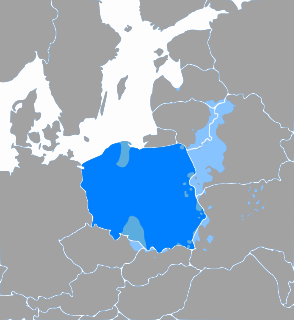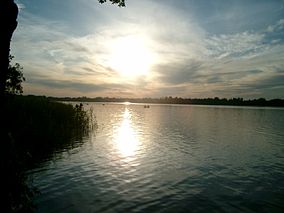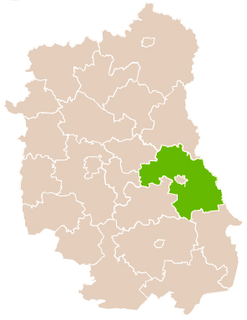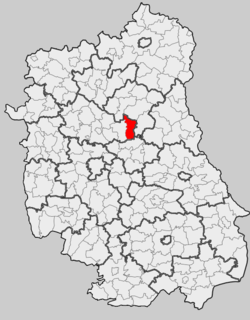| Łęczna Lake District Landscape Park | |
|---|---|
| Park Krajobrazowy Pojezierze Łęczyńskie | |
IUCN category V (protected landscape/seascape) | |
Lake Białe in the Łęczna-Włodawa Lakeland (Pojezierze Łęczyńsko-Włodawskie) | |
| Location | Lublin Voivodeship |
| Area | 118.16 km² |
| Established | 1990 |
Łęczna Lake District Landscape Park or Łęczna Lakeland Scenic Park (Polish : Park Krajobrazowy Pojezierze Łęczyńskie) is a protected area (a Landscape Park) in eastern Poland, established in 1990, covering an area of 118.16 square kilometres (45.62 sq mi) in the geographic region called the Łęczna-Włodawa Lakeland (Pojezierze Łęczyńsko-Włodawskie) or the Łęczna-Włodawa Plain (Równina Łęczyńsko-Włodawska).

Polish is a West Slavic language of the Lechitic group. It is spoken primarily in Poland and serves as the native language of the Poles. In addition to being an official language of Poland, it is also used by Polish minorities in other countries. There are over 50 million Polish language speakers around the world and it is one of the official languages of the European Union.

Protected areas or conservation areas are locations which receive protection because of their recognized natural, ecological or cultural values. There are several kinds of protected areas, which vary by level of protection depending on the enabling laws of each country or the regulations of the international organizations involved.

Poland, officially the Republic of Poland, is a country located in Central Europe. It is divided into 16 administrative subdivisions, covering an area of 312,696 square kilometres (120,733 sq mi), and has a largely temperate seasonal climate. With a population of approximately 38.5 million people, Poland is the sixth most populous member state of the European Union. Poland's capital and largest metropolis is Warsaw. Other major cities include Kraków, Łódź, Wrocław, Poznań, Gdańsk, and Szczecin.
The Park lies within Lublin Voivodeship: in Lubartów County (Gmina Ostrów Lubelski, Gmina Uścimów) and Łęczna County (Gmina Ludwin, Gmina Puchaczów). [1]

Lublin Voivodeship, or Lublin Province, is a voivodeship, or province, located in southeastern Poland. It was created on January 1, 1999, out of the former Lublin, Chełm, Zamość, Biała Podlaska and (partially) Tarnobrzeg and Siedlce Voivodeships, pursuant to Polish local government reforms adopted in 1998. The province is named after its largest city and regional capital, Lublin, and its territory is made of four historical lands: the western part of the voivodeship, with Lublin itself, belongs to Lesser Poland, the eastern part of Lublin Area belongs to Red Ruthenia, and the northeast belongs to Polesie and Podlasie.

Lubartów County is a unit of territorial administration and local government (powiat) in Lublin Voivodeship, eastern Poland. It was established on January 1, 1999, as a result of the Polish local government reforms passed in 1998. Its administrative seat and largest town is Lubartów, which lies 25 kilometres (16 mi) north of the regional capital Lublin. The county also contains the towns of Kock, lying 23 km (14 mi) north-west of Lubartów, and Ostrów Lubelski, 18 km (11 mi) east of Lubartów.

Gmina Ostrów Lubelski is an urban-rural gmina in Lubartów County, Lublin Voivodeship, in eastern Poland. Its seat is the town of Ostrów Lubelski, which lies approximately 18 kilometres (11 mi) east of Lubartów and 34 km (21 mi) north-east of the regional capital Lublin.
The best known recreational area within the Łęczna Lakeland surrounds the White lake (Jezioro Białe Włodawskie), with the resort town called Okuninka.

Okuninka is a village in the administrative district of Gmina Włodawa, within Włodawa County, Lublin Voivodeship, in eastern Poland, close to the border with Belarus. It is located approximately 6 kilometres (4 mi) south of Włodawa and 74 km (46 mi) north-east of the regional capital Lublin.











